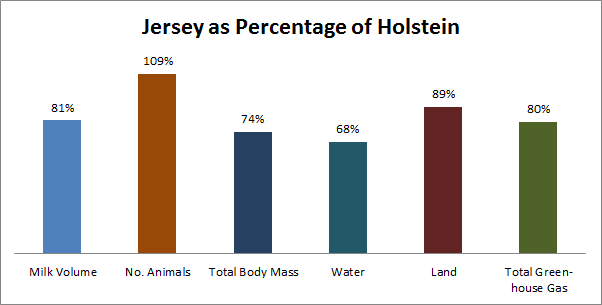For years, Jersey breeders have touted their high fertility rates, calving ease, and greater milk solids than Holsteins as a viable alternative to Holstein breeders looking to increase their profits. A recent Holstein International article, Feed Conversion: Building a More Efficient Engine, adds another item to the list, feed conversion.
Jersey the More Efficient Engine
A recent research paper in the Journal for Dairy Science compared the input requirements of two different production systems, Holsteins and Jerseys to produce a given amount of cheese. In their research of over 13,000 herds spread across 45 states, Dr. Jude Capper and Dr. Roger Caddy found that it would take 109 Jerseys to produce the same amount of cheese as 100 Holsteins. What they also found was that they would have just 74% of the body mass and produce 81% of the milk volume, 80% of the Green House Gases and would only require 68% of the water and 89% of the land requirements. So in essence Jerseys would be more efficient at producing the same amount of cheese.
In their article, Holstein International also points out another Dairy Science paper published last year that looked at feed intake studies for 4 breed groups: Holstein, Holstein x Jersey, Jersey x Holstein and Jersey where all cows were fed the same ration, were housed in the same type of pens and were milked together. The results found that Holstein had the highest intake and the highest production yield. However, Jersey converted a higher percentage of their intake to production than Holstein did.
| Item | Holstein |
HJ |
JH |
Jersey |
| Intake |
9,813 |
9,309 |
9,487 |
7,969 |
| Growth |
669 (6.8%) |
599 (6.4%) |
496 (5.2%) |
334 (4.2%) |
| Maintenance |
1,666 (27.25) |
2,468 (26.5%) |
2,425 (25.6%) |
2,085 (26.2) |
| Pregnancy |
27 (0.3%) |
32 (0.3%) |
33 (0.3%) |
21 (0.3%) |
| Production |
5,968 (60.8%) |
6,057 (65.1%) |
6,162 (65.0%) |
5,259 (66.0%) |
New Zealand Leading the Way
As the dairy industry moves away from focusing solely on overall production and starts to focus more on the overall profitability of their farming operations, key metrics like feed conversion are sure to gain increased importance in breeding programs. Similar to how Scandinavian countries lead the way with Health traits, countries like New Zealand are leading the way by using body weight as an indicator of feed intake and making it apart of the Breeding Worth (BW) index. Countries such as Australia have also started to incorporate weight into their national indexes by using type classification data as a predictor of body weight. While body weight in time may not be the best measure of efficiency, it is what is currently available. One of the interesting findings was that even under the New Zealand system the cows are getting larger, though at a slower than expected rate.
The Bullvine Bottom Line
It is clear that the dairy industry is moving towards producing a more profitable cow. With low heritable health traits already gaining a great deal of focus, it only makes sense that the next step will include efficiency. For many Holstein breeders this may be a wake up call that they need. In the same way that other industries first focused on overall production and then had to put more focus on efficiency, dairy producers now have to do the same. For many breeders this may mean either cross-breeding with the more efficient Jersey bloodlines or putting greater focus on efficiency in their breeding programs. Never forget for one moment that feed costs represent 55% of the inputs on a dairy operation. Efficiencies gained here can be significant. It’s no longer about who can produce the most, it is about who can produce the most with the least cost.
Not sure how much to spend on that great 2 year old?
Want to make sure you are investing your money wisely? Download our Dairy Cow Investment Calculator.













